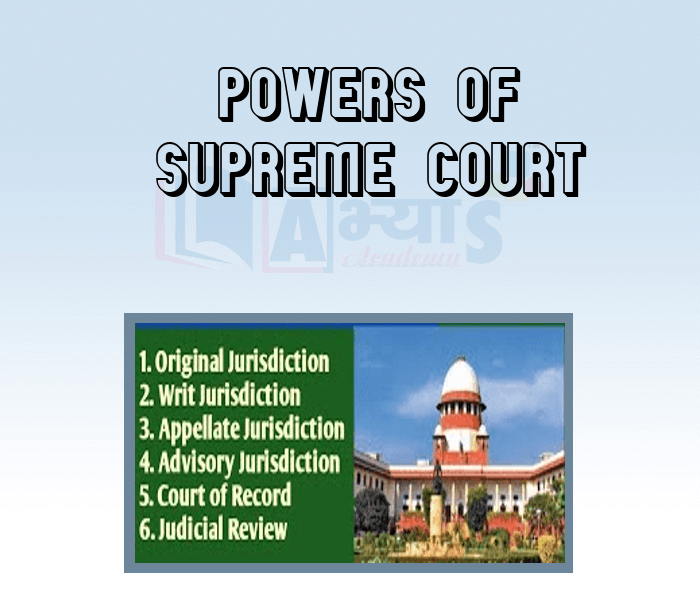Powers of Supreme Court










Power of Supreme Court
Court of Record
(A) The decisions or proceedings of the Supreme Court are records and these records are kept everywhere as witnesses so that they can be presented before subordinate courts as evidence or pre-judgments in future. No question can be raised in any court regarding their authenticity
(B) The Supreme Court has the power to punish a person for contempt of court
Judicial Review of Laws
Judicial review is adopted in the Indian Constitution from the Constitution of the United States of America. In the Indian Constitution, Judicial Review is dealt with under Article 13, which states that
1. All pre-Constitutional laws, after the coming into force of Constitution, if in conflict with it in all of some of its provisions, then the provisions of Constitution will prevail and the provisions of that pre-Constitutional law will not be in force until an amendment of the Constitution relating to the same matter. In such situation, the provision of that law will again come into force, if it IS compatible with the Constitution as amended. This is called the Theory of Eclipse.
2. In a similar manner, laws made after adoption of the Constitution by the Constituent Assembly must be compatible with the Constitution, otherwise the laws and amendments will be deemed to be void-ab-initio.
3. In such situations, the Supreme Court or High Court interprets the laws as if they are in conformity with the Constitution. If such an interpretation is not possible because of inconsistency, and where a separation is possible, then the provision that is inconsistent with Constitution is considered to be void. In addition to article 13, articles 32, 124, 131, 219, 228 and 246 provide a Constitutional bass to the Judicial review in India.
The Supreme Court has exercised the Power of Judicial Review in various cases, such s the Golaknath case 1967, the Keashwanand Bharti case 1973, and the Minerva mills case.
The System of Judicial review is ________________ | |||
| Right Option : D | |||
| View Explanation | |||
Judicial review is adopted in the Indian Constitution from the Constitution of the ____________________________. | |||
| Right Option : A | |||
| View Explanation | |||
The Supreme Court of India is a 'Court of Records'. It means ______________________ | |||
| Right Option : B | |||
| View Explanation | |||
Students / Parents Reviews [10]
Abhyas Methodology is very good. It is based on according to student and each child manages accordingly to its properly. Methodology has improved the abilities of students to shine them in future.

Manish Kumar
10thOne of the best institutes to develope a child interest in studies.Provides SST and English knowledge also unlike other institutes. Teachers are co operative and friendly online tests andPPT develope practical knowledge also.

Aman Kumar Shrivastava
10thAbout Abhyas metholodology the teachers are very nice and hardworking toward students.The Centre Head Mrs Anu Sethi is also a brilliant teacher.Abhyas has taught me how to overcome problems and has always taken my doubts and suppoeted me.

Shreya Shrivastava
8thAbhyas is a complete education Institute. Here extreme care is taken by teacher with the help of regular exam. Extra classes also conducted by the institute, if the student is weak.

Om Umang
10thBeing a parent, I saw my daughter improvement in her studies by seeing a good result in all day to day compititive exam TMO, NSO, IEO etc and as well as studies. I have got a fruitful result from my daughter.

Prisha Gupta
8thMy experience was very good with Abhyas academy. I am studying here from 6th class and I am satisfied by its results in my life. I improved a lot here ahead of school syllabus.

Ayan Ghosh
8thIt was good as the experience because as we had come here we had been improved in a such envirnment created here.Extra is taught which is beneficial for future.

Eshan Arora
8thA marvelous experience with Abhyas. I am glad to share that my ward has achieved more than enough at the Ambala ABHYAS centre. Years have passed on and more and more he has gained. May the centre flourish and develop day by day by the grace of God.

Archit Segal
7thMy experience with Abhyas is very good. I have learnt many things here like vedic maths and reasoning also. Teachers here first take our doubts and then there are assignments to verify our weak points.

Shivam Rana
7thMy experience with Abhyas academy is very good. I did not think that my every subject coming here will be so strong. The main thing is that the online tests had made me learn here more things.
